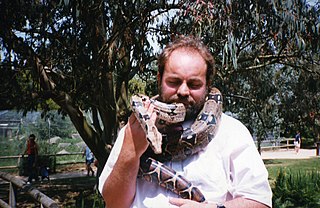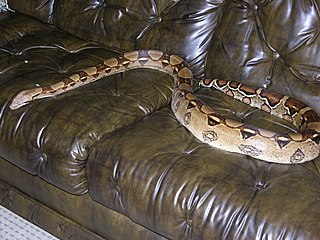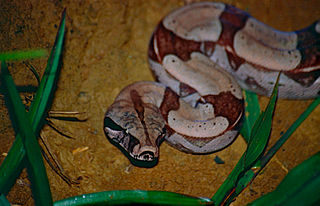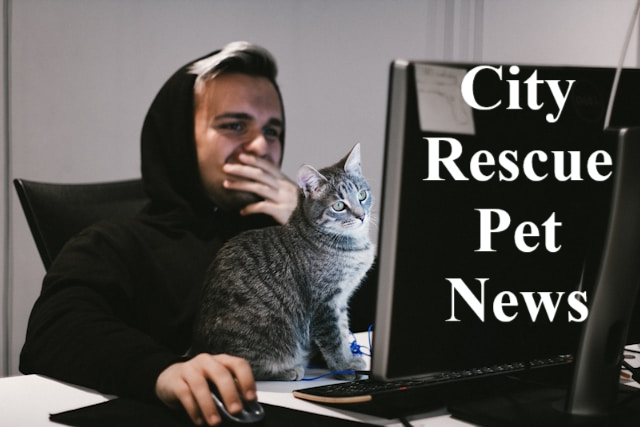- Home
- Best Pet for Me
- Boa Constrictor as a Pet (or Any Constrictor)
Boa Constrictor as a Pet (or Any Constrictor): Impressive, Tame, but Best for Experienced Owners
 https://commons.wikimedia.org/wiki/File:Boa_constrictor,_boa_constrictora.jpg
https://commons.wikimedia.org/wiki/File:Boa_constrictor,_boa_constrictora.jpgHaving a Boa Constrictor as a pet is a popular choice for many people.
All constrictors can be good pets because they are pretty impressive looking and they can be quite tame.
They are generally not considered good for beginners because of the training that is involved, their large size, and their strength.
You really need to understand the snake so that it stays safe around you.
Boa constrictors are originally from Central and South America and the Caribbean. They exist in a variety of habitats such as the edges of rainforest clearings or edges, woodlands, grasslands, dry tropical forests, and semi-deserts.
Safe and Tame: Why Constrictor Snakes Aren't a Threat to Humans, But Should Be Handled with Care
They are not a danger to humans, even children.
Humans are much too large for a constrictor to eat.
They are generally quite tame, especially domesticated snakes.
But they will bite hard if they are scared, threatened, handled too close to mealtime, or overly stressed. They are not venomous, but the bite will hurt.
They are big and strong but don’t attack people. So, in general it is pretty safe to have a boa constrictor as a pet.
Boa Constrictor as a Pet: Build Trust and Create a Comfortable Bond
 https://commons.wikimedia.org/wiki/File:Snake,_Jersey_Zoo.jpg
https://commons.wikimedia.org/wiki/File:Snake,_Jersey_Zoo.jpgWhen handled regularly and in a calm, gentle manner, boa constrictors as a pet can develop a fondness for their human companions, even enjoying the warmth of your body as they rest on you.
These snakes, like many reptiles, thrive on routine and will often become more relaxed over time, especially if they feel secure and not threatened.
While they may seem aloof at first, they have a natural inclination to seek out warmth, and the heat from your body can be incredibly comforting to them.
However, it’s important to remember that boa constrictors are naturally shy creatures, and they do enjoy having a space to hide when they feel stressed or vulnerable.
If they’re given the opportunity to retreat to a safe, quiet place, they’ll feel much more secure. When you show patience and respect for their needs, avoiding sudden movements or stressful situations, your boa will likely thrive in your care.
Over time, with trust and consistency, they can become quite relaxed, forming a bond with you as their handler.
Boa Constrictor Sleep Patterns: Handling Should Only Happen When You're Both Awake
Boa constrictors are nocturnal creatures, preferring to sleep during the day and become active at night.
While some snake enthusiasts might be tempted to share their bed with their boa, this is generally not a good idea. Not only could you accidentally injure the snake in your sleep by rolling over or shifting, but it also poses a risk to the snake’s safety. These snakes, being natural explorers, might slither off in the night and disappear into your home, potentially putting themselves in dangerous situations or making it difficult to find them.
To ensure the well-being of both you and your boa constrictor as a pet, it’s best to handle them during the hours when you're both fully awake and alert. This will help prevent any unintentional harm to your pet and ensure that you have full control of the situation.
Additionally, sticking to a routine where you interact with your boa when you're both active and aware will help build trust and create a safer, more enjoyable experience for both of you.
Boa Constrictors: A Closer Look at Their Impressive Size and Strength
 https://commons.wikimedia.org/wiki/File:Boa_constrictor_on_couch.jpg
https://commons.wikimedia.org/wiki/File:Boa_constrictor_on_couch.jpgBoa constrictors are impressive and powerful snakes, known for their large size and muscular build.
On average, adult boas measure between 4 to 7 feet in length, though some individuals can grow even longer, reaching impressive lengths of 10 feet or more in certain cases.
Female boa constrictors are typically larger than males, often surpassing them in both length and weight.
These snakes can easily weigh 30 pounds or more, with some particularly large individuals tipping the scales at up to 50 pounds or even beyond.
Their substantial size and strength make them awe-inspiring creatures to keep as pets, but they also require careful handling and appropriate space to ensure they remain healthy and comfortable.
Creating the Perfect Habitat for Your Boa Constrictor: Humidity and Temperature Essentials
A boa constrictor as a pet doesn’t require special lighting, but they thrive in environments with high humidity levels, typically between 55-75%.
To maintain the ideal humidity, it’s helpful to provide a water dish large enough for your snake to soak in, or even a small waterfall feature placed in the cooler end of the enclosure. This will not only give your boa a source of water but also help regulate the humidity.
Another great way to maintain the right moisture level is by using moss as a cage liner, which naturally holds and releases moisture, keeping the habitat comfortably humid.
In addition to humidity, a proper temperature gradient is essential for your boa's health.
Within the enclosure, you should have a range of temperatures that allows your snake to choose where it feels most comfortable.
The hot spot should be around 95°F, providing warmth for digestion and activity, while the cooler end of the enclosure should remain around 80°F, allowing your boa to cool down when necessary.
This gradient mimics the natural environment of a boa constrictor, where they can move between warm and cool areas to regulate their body temperature and stay healthy.
Physical Layout of the Habitat for Your Pet Boa Constrictor
 https://commons.wikimedia.org/wiki/File:Columbian_Red_Tail_Boa_(Boa_constrictor_constrictor)_(10364706584).jpg
https://commons.wikimedia.org/wiki/File:Columbian_Red_Tail_Boa_(Boa_constrictor_constrictor)_(10364706584).jpgBoa constrictors are versatile when it comes to their environment, enjoying both ground-level spaces and the opportunity to climb.
In their natural habitats, they spend time slithering along the forest floor and winding their way through trees, so it’s important to offer them both options in their enclosure.
Providing a secure, cozy hiding place on the ground gives them a sense of safety, while branches or sturdy climbing structures allow them to mimic their natural behavior of curling around and exploring elevated spaces. This combination helps keep them mentally and physically stimulated, which is essential for their well-being.
When setting up the bottom of the cage, it’s crucial to use materials that are absorbent, easy to clean, and gentle on their sensitive skin. Good choices include paper towels, reptile carpets, or moss, which can all help maintain a clean and comfortable environment. These materials also assist in regulating humidity, adding to the overall comfort of the snake’s habitat.
The size of the enclosure is another important consideration. As boas grow, they need plenty of space to move around.
A fully grown adult boa constrictor will require a spacious enclosure—typically a 75-gallon aquarium or a similarly sized habitat would be ideal.
The enclosure should allow for a comfortable temperature gradient and ample space to explore.
It's also vital to make sure the top of the cage is securely fastened. Boa constrictors are strong and inquisitive, and without a well-secured lid, there’s always a risk that your snake could find its way out and cause chaos in your home.
Ensuring the cage is both spacious and secure will provide your boa with a safe, comfortable living environment that encourages natural behaviors.
Feeding Your Boa Constrictor: A Guide to Proper Meal Schedules and Prey Size
Feeding schedules for a boa constrictor as a pet vary depending on their age and size.
Baby snakes, still growing and developing, require more frequent meals, typically eating once a week or even a couple of times a week to sustain their rapid growth.
As they mature, their feeding schedule becomes less frequent. Adult boa constrictors, especially the larger ones, generally only need to eat every other week, as their slower metabolism and larger body size allow them to go longer between meals.
The size of the prey should always correspond to the size of the snake. For a healthy feeding experience, the prey should be no larger than the snake’s widest girth, as anything too big could lead to digestion issues.
Baby boa constrictors typically eat smaller prey such as mice, while larger adults can consume much bigger meals, such as rabbits.
It’s important to remember that boa constrictors, unlike some other species, do not need live prey. They are perfectly fine eating already dead animals, which can be easier and safer for both the snake and the owner. Offering pre-killed or frozen-thawed prey is often recommended, as it eliminates the potential dangers associated with feeding live animals.
This feeding approach allows your boa to enjoy a nutritious meal without the stress and risk of chasing and capturing live prey.
Boa Constrictors: A Lifelong Commitment, Health Considerations, and Conservation Challenges
Boa constrictors are long-lived reptiles, with a lifespan that can span an impressive 20 to 30 years, making them a serious commitment for any potential pet owner. This longevity means you'll be sharing your life with your boa for decades, requiring consistent care and attention to their well-being throughout their entire lifespan.
However, like all pets, boa constrictors can face health challenges. Common issues that may arise include scale rot, a condition where the snake's scales become infected or damaged, respiratory problems which can be exacerbated by improper humidity or temperature levels, and Inclusion Body Disease (IBD), a viral illness similar to AIDS in humans that can cause neurological issues and is often fatal.
It’s important to monitor your snake’s health regularly and consult with a reptile veterinarian if you notice any signs of illness.
Boa constrictors are also unique among many snake species in their reproductive habits. Unlike most snakes that lay eggs, female boas give birth to live young. This makes them ovoviviparous, meaning the eggs develop inside the mother's body before the babies are born fully formed.
The babies are independent almost immediately after birth, capable of moving and hunting for food, though they still rely on their mother's protection in the early days. The birth of these live young adds a fascinating dimension to their life cycle.
In addition to being prized as pets, boa constrictors have historically been hunted for their skins, which are highly valued in the fashion industry. The skin of the boa is used to create luxury accessories such as shoes, belts, and bags. This has led to concerns over conservation, as excessive hunting can threaten the populations of these majestic creatures in the wild.
Responsible and sustainable care for boas, both in the wild and in captivity, is crucial for their continued survival.
To find out about other reptile pets and pets of other species, return to the Best Pet For Me page.







New! Comments
Have your say about what you just read! Leave me a comment in the box below.